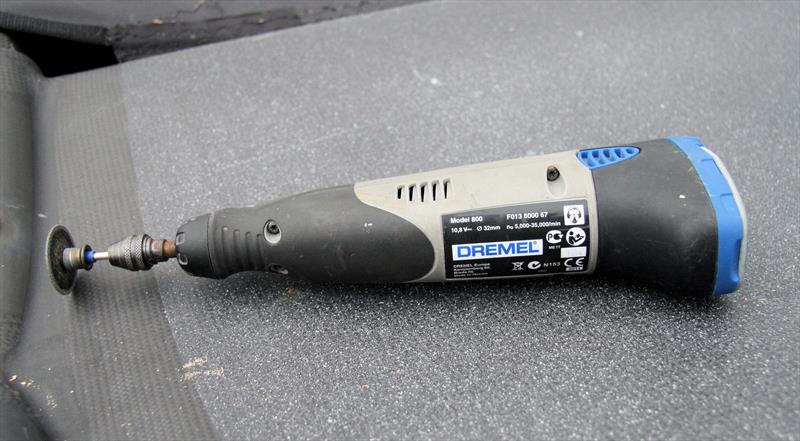
Dremel: The Moth sailor's best friend
by Mark Jardine 12 Jul 2018 04:28 PDT
11-14 July 2018

The Dremel © Mark Jardine / IMCA UK
One of the familiar sounds in the dinghy park at any International Moth event is the whirr of the battery-powered Dremel and then the grind of carbon.
Modifications and upgrades take place constantly and it's during events that sailors spot changes on other boats and then implement it on their boat before the day's racing.
I spoke to Tom Offer about the Moth sailor's friend...
"The Dremel is multi-purpose; you've got a cutting tool, a drilling piece and you can use it in a variety of different ways - grinding and cutting bits of carbon – it works for everything really."
The Moth class is the ultimate tinkerer's boat and many of the Moth suppliers turn up to events with a batch of new parts:
"You're always trying new bits of equipment and when you put something new on there's always going to be a bit of fettling to do, making sure that a new bit of carbon fits flush with the area you're marrying it up to – there's always a bit of trimming involved."
As with any power tool, and some of the tight, enclosed spaces that the work needs to be done on, accidents can happen - as Tom knows from personal experience:
"With my new Rocket SSD I had to put Exocet foils on it, and fitting the foils is quite a precise bit of work getting the foils pinned at just the right angle of attack. I had the boat upside-down on trestles with the main foil in place and I had to oversize the holes on the centreboard case so that I could then glue some bushes in to hold everything in the right place.
"Underneath the fairing is quite difficult to get to and so the Dremel had to be underneath the fairing, so I could get a nice angle onto the centreboard case to make the hole that I wanted to make. I was using a tile cutting piece so the Dremel spins at quite a high rate and was holding it by my finger tips as the rest of the Dremel was underneath the fairing, tapping the centreboard case with the cutter, and unfortunately my fingers touched the spinning area of the tool and I had to let it go, meaning it slid inside the fairing and lodged itself there, still spinning.
"Luckily the bit was spinning in air, but I knew I couldn't shake or move the boat as I'm sure it would have done some damage, so I just had to wait for the battery to run out three hours later!"
Tom's sure the Moth class would be lost without the Dremel:
"While there are other tools out there, the battery-powered Dremel is pretty unique in the way you can apply it to the bits you need to do on the boat."
As the Moth class continues to evolve I'm sure the sound of Dremels in the dinghy park will continue well into the future.